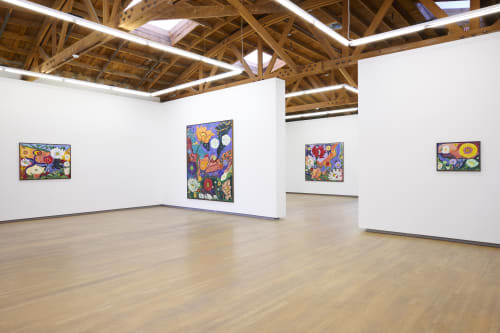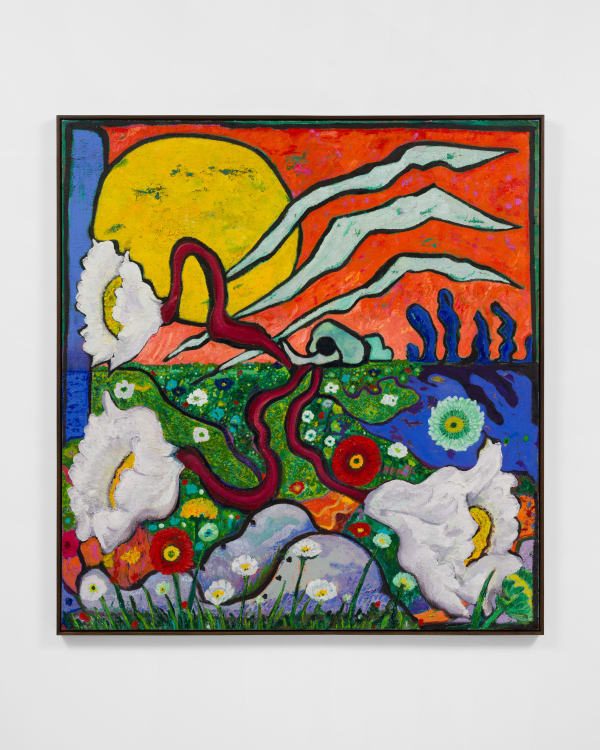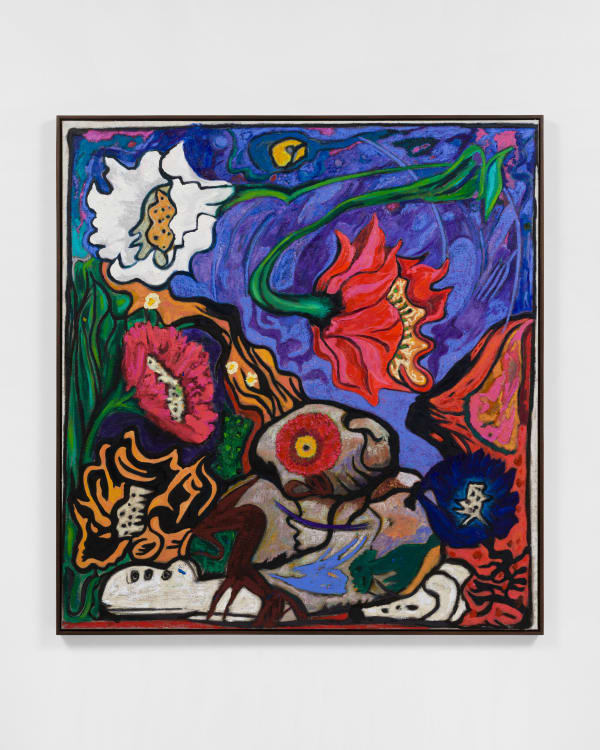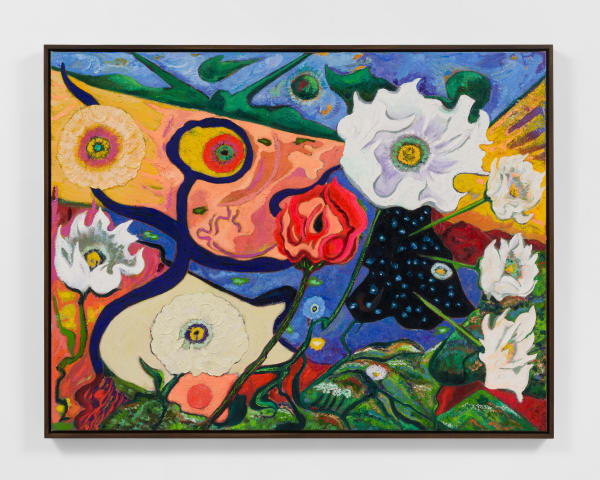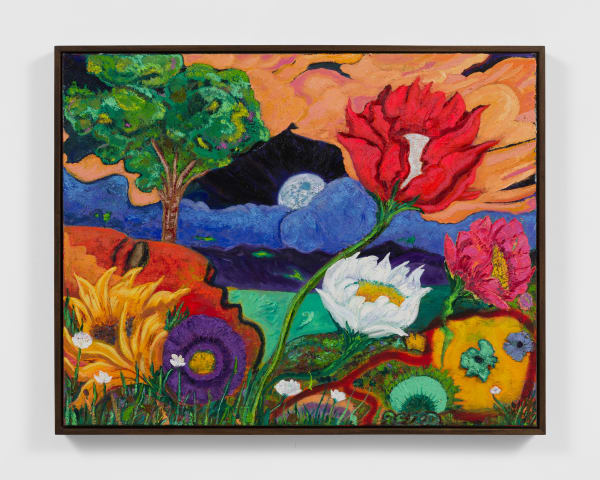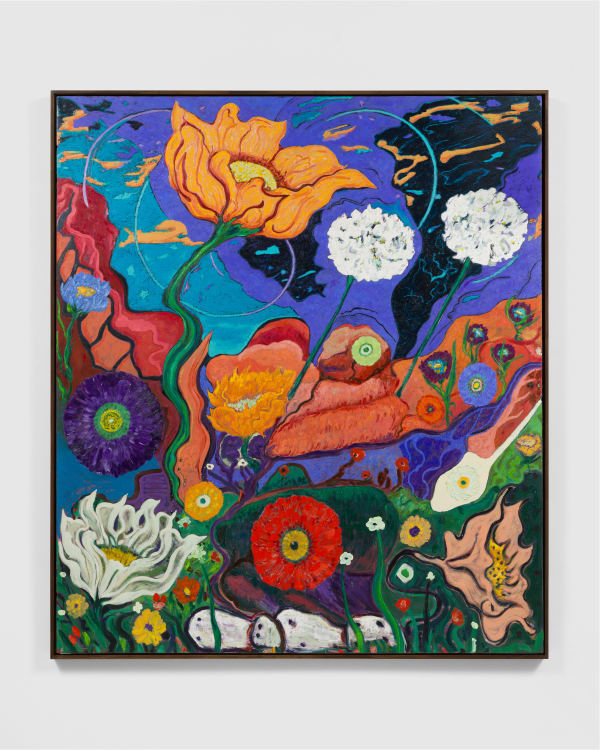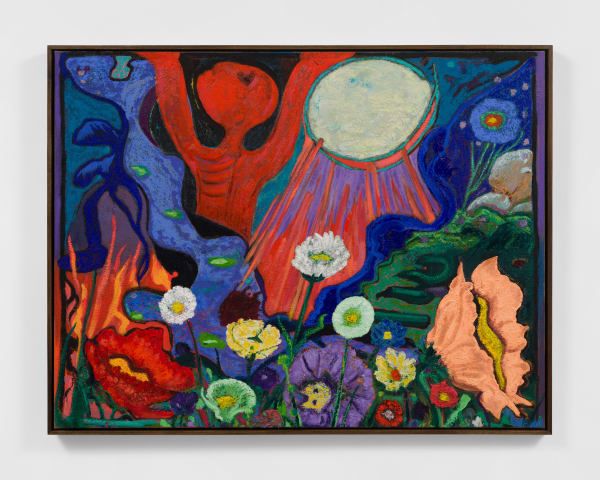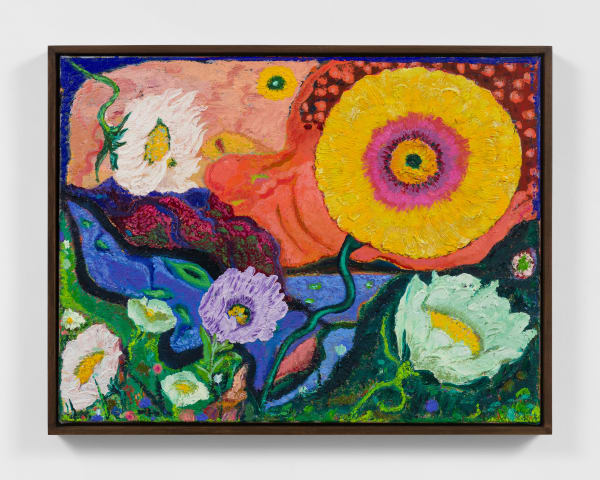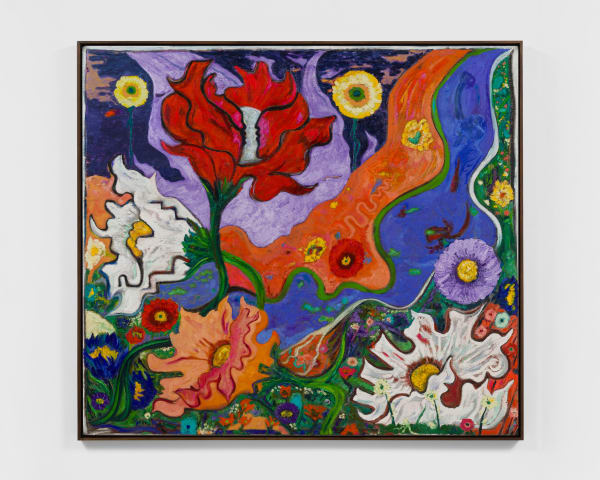Daniel Gibson: Chasing the Black Bird
Nazarian / Curcio is pleased to present Chasing the Black Bird, a solo exhibition by Los Angeles-based artist Daniel Gibson. This will be the artist’s second solo exhibition at the gallery.
Daniel Gibson has long explored the natural world in his paintings as a means to address notions of hardship, resilience, and freedom. In opposition to the harsh desert landscape of his youth, the artist renders his paintings as lush botanical spaces full of thriving flora and fauna, and loaded with a symbology that connects to his Mexican-American heritage. At an early age, Gibson witnessed the bleak realities of migration to the United States from the California border with Mexico. To cope with what he knew would be a near impossible journey for so many, he turned to his imagination, conjuring a bountiful landscape that could support these weary migrants, often envisioning each individual as a flower populating this new land. These childhood memories, dreams, and fantasies have come to be the root of his artistic practice.
The exhibition’s title, Chasing the Black Bird, is a reference to the artist’s decades-long daily meditation practice. During his painting process, Gibson often conjures a visual mantra, repeatedly envisioning a blackbird in flight, moving through the plane of the canvas. Chasing this visual in his mind, the artist transcribes the bird's path as lines on his canvas, creating the start of his composition. This intuitive process leads to an organic unfolding of forms that collapse the figure-ground relationship, challenging traditional spatial hierarchies, and creating a path for his established lexicon of symbols.
The foundation of these newest paintings are rooted in Gibson’s drawing practice, making use of near continuous black lines to define his compositions. While retaining a representational quality, the works in Chasing the Black Bird lean further towards abstraction, creating a dynamic interplay between form and narrative. The relationship between figure and ground has become more flattened and stacked, with flowers emerging monumentally in the foreground and the deep space of the land stacked like geological strata. The artist’s color palette has also shifted to deep blues, purples and greens, punctuated with coral, yellow, and white, all separated from a decisively rendered black line.
Influences from American artists Arthur Dove and Marsden Hartley can be seen in the artist's use of color, texture, and organization of space, while the graphic nature of his line and form references German Expressionism. As he navigates these influences, Gibson imbues his compositions with an emotional weight and deep reverence for the cyclical nature of life and the human experience, reflecting on his earliest years along the border.
Chasing the Black Bird is a testament to Gibson's continued evolution as an artist, highlighting his commitment to pushing the visual boundaries of his practice, while remaining deeply connected to the genre of landscape painting as a conceptual framework to discuss memory, migration, and the untold stories of those that venture into the United States in search of a better future.
Daniel Gibson (b. 1977 Yuma, AZ; Lives and works in Los Angeles, CA) has had solo and two-person exhibitions at Shulamit Nazarian, Los Angeles, CA; Almine Rech, New York and Paris; Brant Timonier, Palm Beach, FL; New Image Art, Los Angeles, CA; Ochi Projects, Los Angeles, CA; LAX Art, Los Angeles, CA; and Mexicali Rose, Baja, Mexico. Recent group exhibitions include the Palm Springs Art Museum, Palm Springs, CA; MUSEA K11, Hong Kong; Institute of Contemporary Art, Miami, FL; Institute of Contemporary Art Los Angeles, CA; Shulamit Nazarian, Los Angeles, CA; The Pit, Los Angeles, CA; Bozo Mag, Los Angeles, CA; and BBQLA, Los Angeles, CA. His works have been written about by the LA Times, WideWalls, Juxtapoz, and Brooklyn Rail and are in the permanent collection of the Dallas Museum of Art, TX, the Institute of Contemporary Art, Miami, FL, and the public collection of the Deji Art Museum, Nanjing, China.
-
 Daniel GibsonChasing the Black Bird, 2024Oil on linen63 x 59 in
Daniel GibsonChasing the Black Bird, 2024Oil on linen63 x 59 in
160 x 149.9 cm
64 ¼ x 60 x ¼ in (framed)
163.2 x 152.4 x 0.6 cm (framed) -
 Daniel GibsonPraying on a Rock, 2024Oil on linen63 x 59 in
Daniel GibsonPraying on a Rock, 2024Oil on linen63 x 59 in
160 x 149.9 cm
64 ½ x 30 ½ in (framed)
163.5 x 77.2 cm (framed) -
 Daniel GibsonTrue Constellations, 2024Oil on linen36 x 47 in
Daniel GibsonTrue Constellations, 2024Oil on linen36 x 47 in
91.4 x 119.4 cm
37 ½ x 48 ¼ in (framed)
95.3 x 122.6 cm (framed) -
 Daniel GibsonHigh View Native Stone, 2024Oil on linen25 x 32 in
Daniel GibsonHigh View Native Stone, 2024Oil on linen25 x 32 in
63.5 x 81.3 cm
26 ¼ x 33 in (framed)
66.7 x 83.8 cm (framed) -
 Daniel GibsonFlowerhead in Blue Gorge, 2024Oil on linen63 x 59 in
Daniel GibsonFlowerhead in Blue Gorge, 2024Oil on linen63 x 59 in
160 x 149.9 cm
64 ½ x 60 x ½ in (framed)
163.5 x 152.4 x 1 cm (framed) -
 Daniel GibsonSleeping, 1977, 2024Oil on linen90 x 78 ½ in
Daniel GibsonSleeping, 1977, 2024Oil on linen90 x 78 ½ in
228.6 x 199.4 cm -
 Daniel GibsonYou Are a Flame of Water, 2024Oil on linen36 x 47 in
Daniel GibsonYou Are a Flame of Water, 2024Oil on linen36 x 47 in
91.4 x 119.4 cm
37 ¼ x 48 ¼ in (framed)
94.6 x 122.6 cm (framed) -
 Daniel GibsonYellow Flower in Stars, 2024Oil on linen19 x 25 in
Daniel GibsonYellow Flower in Stars, 2024Oil on linen19 x 25 in
48.3 x 63.5 cm
20 ¼ x 26 ¼ in (framed)
51.4 x 66.7 cm (framed) -
 Daniel GibsonManzanita, 2024Oil on linen67 x 75 in
Daniel GibsonManzanita, 2024Oil on linen67 x 75 in
170.2 x 190.5 cm -
 Daniel GibsonRed Earth Green River, 2024Oil on linen67 x 75 in
Daniel GibsonRed Earth Green River, 2024Oil on linen67 x 75 in
170.2 x 190.5 cm -
 Daniel GibsonRunning Son, 2024Oil on linen19 x 25 in
Daniel GibsonRunning Son, 2024Oil on linen19 x 25 in
48.3 x 63.5 cm
20 ¼ x 26 ¼ in (framed)
51.4 x 66.7 cm (framed) -
 Daniel GibsonTwo Left Shoes Under Rock Shadow, 2024Oil on linen32 x 25 in
Daniel GibsonTwo Left Shoes Under Rock Shadow, 2024Oil on linen32 x 25 in
81.3 x 63.5 cm
33 x 26 in (framed)
83.8 x 66 cm (framed)
